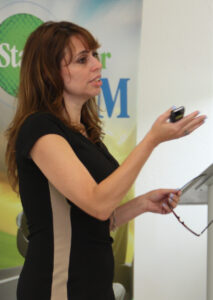Everyone is a leader. The question is: What is your personal leadership style?
Jodi Grinwald, founder of Today is the Day, defines leadership styles according to a process called Energy Leadership.TM As she explains it, the program is more about becoming the kind of a leader you want to be than identifying what kind of a leader you are.
Thinking about leadership in terms of positive energy or negative energy will help individuals understand why others react to them the way they do, Grinwald explained at a summer meeting of NJBIA’s Women Business Leaders Network. Speaking to 40 women at Berkeley College, she pointed out that once people become aware of their energy levels, they are in a position to change them for the better; they can choose to bring a more positive, can-do attitude to the workplace.
Anyone who has walked into a crowded room and had a bad feeling for no apparent reason has experienced what is at the heart of energy leadership.
Join Us for the Women Business Leaders Forum, Sept. 15
Anabolic energy is uplifting, and is the energy people feel when they are inspired, motivated and happy. Catabolic energy, on the other hand, is what we feel under stressful situations. It drains us and produces cortisol and other chemical reactions in our bodies that can cause many health issues including high blood pressure, heart disease, impaired cognitive function and sleep disruption.
“When you are listening to someone share what they are going through or you are sharing your own experience with them, you are each taking the other along for the ride,” Grinwald said. “It can be a positive, uplifting and inspiring ride or a negative, downer, paralyzing ride.”
As an exercise, Grinwald asked everyone to partner with someone near them. Each person then had to share something that totally frustrates them and then something that inspires them and why.
“When examples were shared each one of us was able to experience everyone’s answers,” she said. “That is why it is so easy to jump on the negative bandwagon when someone is sharing their issues. We quickly join them down the rabbit hole instead of turning the situation around and allowing for a different more positive perspective.
“It truly is a choice on how you see things,” she added.
So what do you want your leadership style to be? Here are descriptions of three out of the seven levels of energy that Grinwald shared with us that morning.
The Victim
Victims lack confidence, have a “can’t-do” attitude and want someone to take care of them. They are apathetic, don’t move decisions forward and often work in crisis mode.
People who find themselves in this level should acknowledge the way they feel and validate it, Grinwald said, then look for one tool or piece of information that can get them going so they are not a victim anymore.
I Win, You Lose
This type of leader is often in conflict with others, feeds on resentment and blame and is highly judgmental. They are also the type to take credit for other people’s work.
“When you say that somebody should have done something, you are in an I-win, you-lose setup,” Grinwald explained, “but do you want to be an I-win, you-lose leader?”
The Fixer
This is the leader that has embraced anabolic energy. They believe they can do anything and make anything happen. They don’t take things personally but, rather, care about others, and have a “how-can-I-help” attitude. The focus is always on team members.
The challenge for those that resonate at this level is that they are so giving of their time and their energy, they have little to no time left to do things they want to do, Grinwald explained.
“They then have a tendency to wind up heading to the victim level under stressful situations,” she said.
Choosing a leadership style requires listening. People are influenced by the leaders they have had in the past, and often, those other voices are the ones they hear.
“We need to quiet all the noise and find our own leadership style,” Grinwald said. “Being aware of what energy level you are in when we are feeling the most connected to your own voice and leadership style can help you maintain your voice.”
For instance, if your department is not doing well, and you call a team meeting, how do you want to handle the situation?
“You can either choose to scold them and share how bad things are (I win, you lose), or you can ask them how they can find the opportunity within the challenge,” Grinwald said.
“We’ve been taught that one size fits all in leadership: ‘These are the goals, this is what has to be done, and we have to get to the result on this day,’” she explained. “For some of the leaders at the top, the CEOs, that’s how they feel. But at the end of the day, the companies that are doing the best are the ones that are listening and care about retaining their employees.”
Jodi Grinwald is a Certified Professional Coach and a Certified Energy Leadership Index Master Practitioner and founder of Today is the Day.


